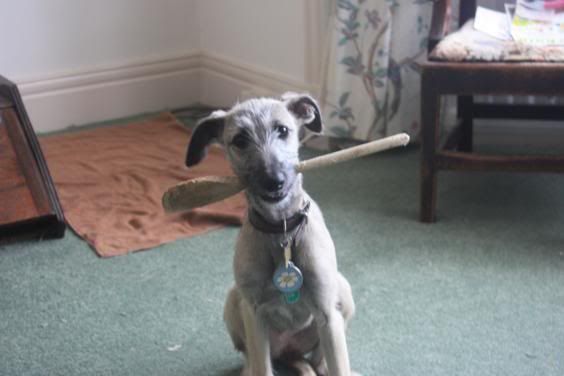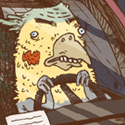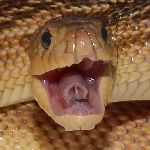|
notsoape posted:Wow; I just looked Brad Pattison up on youtube and holy crap. Finally looked him up too and I'm guessing we saw the same video. He gets annoyed at some lady, smacks her dog, then says "You don't even have a 6ft leash In his official training videos he kind of has that crazy eye going on.
|
|
|
|

|
| # ? May 15, 2024 08:32 |
|
a life less posted:It's the Joe Average who ends up paying your bills though, and he wants to see big changes in short amounts of time. Brad Pattison gets on my nerves even more than the BBC guy. He's obnoxious and I absolutely cannot fathom why anyone would give him the time of day. I can imagine Millan for example being a nice guy to be around and convincing if you don't know any better, but how Pattison manages to get people to trust him is a mystery to me.
|
|
|
|
Rixatrix posted:I tend to think people simply like to see dogs bullied. This is something I've been wondering about too. Sometimes it feels like people are just waiting for an 'excuse' to yell at their dogs and physically intimidate them. I'd like to think better of people though  . .The RSPCA has released their official statement: quote:RSPCA Statement in response to The One Show feature on dog behaviour – 21.9.11 It will be interesting to see where the programme goes from here.
|
|
|
|
notsoape posted:This is something I've been wondering about too. Sometimes it feels like people are just waiting for an 'excuse' to yell at their dogs and physically intimidate them. For your average, frustrated dog owner, if they are taught by 'reputable trainers' that it is acceptable--even good--to shout at, bully, jab, kick, etc, your dog, then hell they'll do it. It is a way for them to vent their frustration over their problems with their dogs; many of the people who use aversive-based training do so not necessarily because they think it will work, really, but because it feels good to vent all that stress. Problems at work? Problems with your marriage? Problems with money? Hey, the dog's misbehaving, better make sure it knows it's place at the bottom of the world! People can be and often are bullies, and bullies especially seem drawn to aversive training. As a brief training-related thing with Lola: I've mentioned before that Lola has a strange relationship with my friend, K. Today I saw K briefly, and took Lola with me in the car to do so. Lola was hesitantly sniffing her when we got there, and then started wagging her tail a little. She had no desire to try and move away from K, and she didn't bark, growl, lift her hackles or anything. Good dog
|
|
|
|
Fraction posted:For your average, frustrated dog owner, if they are taught by 'reputable trainers' that it is acceptable--even good--to shout at, bully, jab, kick, etc, your dog, then hell they'll do it. It is a way for them to vent their frustration over their problems with their dogs; many of the people who use aversive-based training do so not necessarily because they think it will work, really, but because it feels good to vent all that stress. Yes, I agree with this. Also, I think that people approach dog training from the wrong angle from the get-go. To us, training is fun, it's mentally healthy and results in a happy and well behaved dog. Approached correctly, it should be a learning game for both dog and owner. But to most people, you want a dog, you get a dog, and then you need to control that dog and that's what training is for. You don't even need to express it in terms of 'dominating' or 'alpha' because it's just so fundamental that dog is lower than human. So if dog doesn't follow the rules (leaving aside that the rules were not actually explained to dog), doesn't do what the human wants, then the dog is bad. What do we do to rule breakers? We punish them. And sometimes we get punished in life and it isn't fair, so why should it be fair for the dog? It's just gravy that the dog (mostly) can't complain about it. I'd say though that it may be that most people don't expect their aversive training to work (making them crazy for trying it over and over...), but they also truly don't believe there's any other way...and of course, they won't make the effort to find out if that's true, so they don't get my pity. I hope they take Victoria up on it though, for the dog's sake. Anyway, yay Lola! We've been doing muzzle work with Psyche and she's been doing really well, but still has triggers where she jumps (and presumably nips) at the person we're working with. Also, no matter what we do, she can always get the muzzle off. She only does it when she's panicking, but her nose is soo short that we can't make it tight enough to stay on. I'm thinking we're going to have to resort to some kind of tie that goes up between her eyes and links the muzzle to the back strap. I'm not sure how best to do it without making her uncomfortable though. Of all her problems, she has to be a Houdini dog too.
|
|
|
|
Sorry to detract from the "holy gently caress BBC are you stupid" discussion but I had some questions on training. 1. Is reactivity something you ideally learn to live with? Bailey has gotten much better about cars and lunging at barking at them unless he is very excited or they are very loud (and therefore, I assume, exciting). I still find it hard to walk him away from our usual routes because even when we walk his potty route where he's comfortable and knows it well, he still reacts on occasion. 2. Bailey is spazzy around other dogs, and while I would like to take him to obedience classes, I don't want to be the rear end in a top hat with the over excited dog that won't stop whining and trying SO HARD to play. I'm working on clicking each time he sees a dog, but I worry that I am just making the appearance of the other dog so rewarding that he's excited for that. Should I just make him sit and then click and treat? How can I reduce his excitement? 3. Bailey has wicked prey drive. He stalks around areas where he thinks squirrels will be, and will lunge at them when he sees them. If they are in the distance and he sees them, he will ignore me. Either he sees them and ignores me completely or he misses them entirely. How can I work on reducing this? He goes really stiff and gets ready to bolt and he just won't listen at all. Thanks and sorry for the wall of text.
|
|
|
|
wtftastic posted:Sorry to detract from the "holy gently caress BBC are you stupid" discussion but I had some questions on training. 1. Remember that dogs don't generalize well on their own, which is why when we train them we take it in steps, adding in more distance or distractions slowly until the dog can perform in any situation. Desensitizing reactivity is the same way, once you get it 90% in a familiar environment, then you have to take it on the road and take it back a few steps. It seems like a regression, but the more you do it, the faster your dog will learn. Now, it's possible that a dog's rehabilitation may plateau or you may decide that you are fine with the status quo and not push onto new situations. So if you are happy and think you'll be able to walk those same routes forever, you could stop there, but I would suggest pushing forward if you are still seeing any amount of progress. 2. If Bailey is responding to you when you click/treat (turning his head or body to get the treat from you), then you can add in asking for behaviors. I ask my dog to sit when she is getting over-excited about another dog because she can't jump up and down if she's sitting. So yeah, try that out and if you can teach Bailey that sitting calmly actually gets him to meet another dog faster (if he has doggie friends) then you can gain control over the meet and greet process and that should lower his out of control excitement. 3. If he's on a leash when he sees a squirrel, then try the Premack principle, which uses the very reinforcing behavior (chasing the squirrel) to encourage less likely behavior (listening to you). So next time he sees a squirrel, don't let him budge until he gives you attention (the slightest head turn at first is fine) and then tell him 'Go get it!' and run after the squirrel. Once he learns that checking in with you and sitting or whatever you ask for gets him the squirrel whereas not doing so gets him nothing, he'll be more responsive. You can also try teaching leave it and such if you haven't, though if he's super focused, I tend to think the Premack principle will work better. It will help if you heavily enforce sitting for reactivity too because eventually your dog will just sit and check in with you whenever he's anxious or excited about anything.
|
|
|
|
Kiri koli posted:Wise dog words. Thanks for the advice; I had considered using Premack (inadvertently, actually). I was letting Bailey wait and then rewarding him with chasing the squirrel, and then I was so worried that I'd get him even more "oh god got to get the thing" than he was before. I am interested in getting him to be able to walk around slightly more busy areas (especially since there are some nice, fairly easy walks I could take him on) and so I guess I need to start pushing him a little bit and going to areas where I think he might be likely to succeed while being pushed. And the turning thing sounds like a good way to see when he's ready to move up. He's getting better and better staying calm further away from dogs. I just really need to make sure I make the most of my time with him each day. I feel like initially he and I made a lot more progress than we are now!
|
|
|
|
wtftastic posted:Thanks for the advice; I had considered using Premack (inadvertently, actually). I was letting Bailey wait and then rewarding him with chasing the squirrel, and then I was so worried that I'd get him even more "oh god got to get the thing" than he was before. I think that this kind of thing is unintuitive most of the time. Like I get told a lot that if I give my dog a treat while she's freaking out, I'm reinforcing her anxiety/growling/barking etc. But that's thinking of it from an outside human training point of view and not the more basic level that my dog has anxiety and if good things happen while she's fearful (but not over threshold), she's going to get less fearful because good things make her feel better. For Bailey, right now he sees a squirrel and feels an out of control excitement. It may have a hint of anxiety or manic-ness because OMG SQUIRRELWHATDOIDOMUSTGETSQUIRREL. If you use the Premack principle to teach him to do a calm check-in with you first, you're not just getting him to act calm, you're getting him to BE calm. Dogs aren't actors. And then it's more like a game he understands. Check-in with owner, get to run after squirrel, yay! I've found that before I started doing this, Psyche would run after a squirrel and hound it up a tree and keep barking after it was out of sight. When I get her to sit and then we run after it together, once it runs away, she no longer cares and we go back to walking. Same with introducing a new treat. At first she's super excited and offering tricks and all over the place. Once I get her to focus and actually do what I want, the treat is still yummy but no longer overwhelming to her little doggie brain.  Progress usually comes in waves as you figure out what's next. I'm sorry to keep harping on my dog as an example, but we made a lot of progress at first just having her exist around other people/dogs without being an anxious wreck, but then our progress slowed for a good while because we needed to change her environment and then we needed to identify her specific triggers when she seemed fine standing right next to a stranger one minute and then was jumping on them the next... Really pay attention to your environment because Bailey has probably desensitized to the things he sees most often (a lot of them, so that's good progress!), but still has some specific triggers that are hard to get rid of. So when he reacts on your normal route, what is he reacting to? The same old, or something new? Is it a particular thing over and over? This can be really hard because some many things that you aren't even aware of can affect this. As yet another Psyche example, we noted that she is really sensitive to people reaching for things, from the ground, from each other, whatever, it sends her into a flying rage. But only sometimes, other times she watches like 'what, am I supposed to care?' without a hint of anxiety. As we kept watching, we realized that if I was paying attention to the reaching, then Psyche didn't care, but if I was distracted even in the slightest way, she would start lunging and growling. Her level of reaction was also worse if a dog was barking in the distance or if other particular things were going on. So that's something we're working on and just knowing what's going on means we can track her progress better and it doesn't feel like some hopeless random reaction. So anyway, sorry for the book. I know how easy it is to get frustrated and I've had many a day when I just break down thinking we're never going to get to a reasonable point with her. But I think it really helps to try and look at reactivity from many points of view because so many things can effect it. You can never figure it out entirely, but you can figure out little things that you can work on or change or try that are creative and seem far outside the basics of training.
|
|
|
|
wtftastic posted:Sorry to detract from the "holy gently caress BBC are you stupid" discussion but I had some questions on training. 1. I've heard that a reactive dog is always reactive, though their reactive fits may be few and far between (or near-extinguished). Basically the groundwork has already been laid for it to be relatively easy for them to fall back on reactivity in certain situations, so it's best to never think of a reactive dog as cured (ie, will never react again). For instance, Cohen will react to dogs she dislikes in stressful environments if I don't actively manage her. She'll also react to motorcycles if my attention dips too much. I can get her to a point where she will exert sufficient self control for it to be almost impossible to tell she used to react in situation X, but the truth of the matter is that she's still a high energy somewhat anxious dog who likes to bark first and think later. 2. So you're clicking each time Bailey sees a dog. What behaviour, exactly, are you marking? Remember that the clicker is a precision marker, and it's not always appropriate in every situation. (I'm not saying it's not appropriate here... just something for you to mull over.) The click is an additional exciting stimulus so it might not be the best choice in this situation. You may be better simply stuffing food into Bailey's mouth. However, inversely, just yesterday I had Cohen out for a walk and she noticed a motorcycle going by - her ears perked up, etc -- I quickly marked that behaviour with a "yes!" because she had noticed the stimulus and had not (yet) reacted to it. The marker broke her attention and she focused on me for her treat. I was caught off guard and did what I could to solve the situation successfully. But if I were to do it over again I think I would have been more proactive and asked for a control behaviour (sit, down, whatever) and focus in the presence of the motorcycle, since that's what I want (as opposed to ears up/body alert/focus on cycle). The purpose of classical conditioning is often to get a dog operant. Once a dog is operant you can begin operant conditioning. As in, a barking crazed mess is not capable of learning. Once you've reduced the craziness via CC you can begin to ask for incompatible behaviours. CC is a powerful tool, but without constant booster sessions the associations can quickly fade. The learning during OC tends to remain for a longer duration with periodic reinforcement. So, basically, that's my really long way to say that it sounds like it's time for you to start asking for other behaviour from Bailey (focus is probably the most important here, but sit, down, etc can work). Just remember to start babystepping it. As in, don't start asking for focus where there's a dog 3 feet away. Start when there's a dog 100 feet away or more, and very gradually start reducing the distance contingent on his continued success. Another idea is to use play as a reward for focus. As in, sit and focus on me and reward with cookies, but once the other dog is around the corner whip out a tug toy and go to town playing with him. Depending on your dog this may help him get his yayas out and be a fabulous reward for self control, or it'll elevate his excitement to unmanageable levels. Depending on the type of training facilities you have in your area they might be quite willing to help you with your problem. You might be able to arrange an assessment where you drop by their facility for a consult while there are other dogs in the room so they can see first hand what you're up against. They'll be able to let you know if they can help, or if you need to do a bit of work on your own to get him to the point where he can function in class. The big go-to self control building games are Crate Games and Its Yer Choice. Crate Games really help a dog hold a stay when there's excitement going on outside the crate. Gradually the ability to self control strengthens and you can babystep it up to more challenging situations. Its Yer Choice is a way for the dog to leave food alone without a cue. Again, as your dog gets used to the exercise you can begin to make it more challenging and apply it to other parts of your life. 3. Kiri koli had good advice about the squirrels. They're probably going to be the most difficult distraction you'll have to deal with (I know it was with me). Something else you can do if he sees a squirrel (or another dog, actually) is to toss a bunch of treats onto the ground in front of him. If he's not completely over-the-top aroused he may break his focus and go after the food. It's a good "oh poo poo" method of controlling the situation by discouraging repetitions of undesired behaviour. Plus it'll save your fingers if he gets a hard mouth when taking treats while excited. a life less fucked around with this message at 15:03 on Sep 22, 2011 |
|
|
|
How do I get my dog to stop mouthing my hands? It's really annoying. She doesn't do it all the time, but when she gets excited and wants to play, she bites all over my hands and arms. She's obviously playing because she doesn't bite hard, but it's annoying. My dog is a German Shepherd, about a year old. I rescued her a few months ago she's been this way since I got her. Any advice on how to approach this?
|
|
|
|
rear end Waffle posted:How do I get my dog to stop mouthing my hands? It's really annoying. She doesn't do it all the time, but when she gets excited and wants to play, she bites all over my hands and arms. She's obviously playing because she doesn't bite hard, but it's annoying. My dog is a German Shepherd, about a year old. I rescued her a few months ago she's been this way since I got her. Any advice on how to approach this?
|
|
|
|
My 9 month old husky still does the biting game. I will say though that yelping makes her more excited. I'm her human squeaky toy. So I stopped the yelping tactic. The walking away thing works if I walk towards the back door as if to put her outside. She is getting better at listening to commands when she get's that excited though. Even if the only one she listens to is go to your bed. She knows that treats are coming if she goes to her bed so it will break through to her. I mainly try to keep her under that crazy bitey excitement level. If she get's too wound up I have to leave the room or put her outside for a minute.
|
|
|
|
Hdip posted:My 9 month old husky still does the biting game. I will say though that yelping makes her more excited. I'm her human squeaky toy. So I stopped the yelping tactic. The walking away thing works if I walk towards the back door as if to put her outside. The only command my dog obeys 100% is "crate" to go to her kennel. I've tried sending her in there for a few minutes when she bites and it does seems to calm her down for a bit. I tried walking away and ignoring but she pounces on my back and bites at my shirt. A friend told me to stick my hand in her mouth and hold her lower jaw for a bit but I don't think that guy has a clue cause it just made the game even more fun for her. I am going to work on "leave it" by asking her to ignore kibble and then offering jackpot treats, then add "leave it" once she knowa the behavior I want. Maybe she can be taught to leave hands alone for treats.
|
|
|
|
rear end Waffle posted:The only command my dog obeys 100% is "crate" to go to her kennel. I've tried sending her in there for a few minutes when she bites and it does seems to calm her down for a bit. I tried walking away and ignoring but she pounces on my back and bites at my shirt. A friend told me to stick my hand in her mouth and hold her lower jaw for a bit but I don't think that guy has a clue cause it just made the game even more fun for her. I am going to work on "leave it" by asking her to ignore kibble and then offering jackpot treats, then add "leave it" once she knowa the behavior I want. Maybe she can be taught to leave hands alone for treats. You shouldn't use her crate as a punishment (and ceasing play when she bites is a form of punishment). A crate should always be a happy, good place your dog wants to go to. That said, time-outs can be very effective for this sort of thing if your dog sees your other attempts as just more play. We use a bathroom for time-outs for the sound dampening factor (we use it for barking at things outside more than biting, but when she mouthed a lot, we used it for that too). Some people don't bother with a separate room, but just use a tether or whatever. Your dog is released from the time out when calm. Leave it is hard for mouthing I think because the dog won't necessarily understand what you mean (your hand is part of you after all). What you can try instead is the Don't Mouth Me! game. If your dog gets excited about your hands and will follow them with her mouth whenever she's in a playful mood, this game is perfect. What you do is you start off in a place with no distractions and have your dog sit or lie down. Then present your hands in a boring way. If your dog does ANYTHING that isn't putting her mouth on you, click and treat. Then do something a little less boring with your hands and continue to click/treat for any behavior that isn't mouthing. You can raise the criteria from not putting teeth on skin to not opening mouth or even following hand with mouth and then slowly work up to you waving your hands in her face, reaching around her sides, etc. This helps to break the habit and show that not mouthing can be as rewarding as mouthing.
|
|
|
|
Kiri koli posted:You shouldn't use her crate as a punishment (and ceasing play when she bites is a form of punishment). A crate should always be a happy, good place your dog wants to go to. I will try this. What should I do if she does mouth my hands during the game? Just don't click treat and try again in a few minutes?
|
|
|
|
rear end Waffle posted:I will try this. What should I do if she does mouth my hands during the game? Just don't click treat and try again in a few minutes? If she does mouth your hands, then just reset by taking your hands away and waiting a few seconds. If she keeps not getting it, then you're making it too hard. Like any training exercise, you want to set her up to succeed, so at first be really, really easy and click right away. Even if she was going to mouth and you get the click in there before she does, that's okay because you can build on it. Remember though that if you click, you have to treat. She won't understand if she doesn't get a treat because you clicked accidentally, it will just weaken the connection between the click and treat. So go slow, be careful with your timing, and if things are frustrating for you or the dog, end the session and try again another time.
|
|
|
|
a life less posted:1. 2. I need to work on crate games and its yer choice. He's actually okay about its yer choice with kibble; if I hold out my hand, he'll sniff and lick for a few seconds and then when I open my hand he just stares at me. Should I click and offer a treat then? (Also does it really screw it up if he's given part of the "bait" as his treat?) As far as crate games go, he'll already go to his kennel on command, but he generally doesn't stay in unless I close him in (and he's okay with that, he never fusses in the crate). Is part of the crate game shaping a "no click and treat until you wait in the crate"? 3. Oh thats a good idea. And my god does he have a hard mouth; he's gotten better since I've started feeding him more often, but I have bruises on my fingers from him grabbing treats. I appreciate all the info from you and Kiri; its great to hear from people with experience with these things. I find it sometimes more helpful than just text book answers.
|
|
|
|
wtftastic posted:
Psyche doesn't go for treats thrown in front of her if she's really focused on some agitator, so that won't work for all dogs. If you can manage the coordination though, you can try feeding from your palm (cupping it like your dog is eating from a feed bag) instead of your finger tips. It really solves the hard mouth problem, though I find it cumbersome and not fast enough for really intense situations. I may just be clumsy though.
|
|
|
|
wtftastic posted:3. Oh thats a good idea. And my god does he have a hard mouth; he's gotten better since I've started feeding him more often, but I have bruises on my fingers from him grabbing treats. When Major is just barely holding himself together he takes treats super hard too. Now when I'm working on reactivity things with him I use easy cheese/kong paste so he can just lick it. Its supposed to be calming and it spares my fingers while allowing him to have continuous rewards. I just ordered this stuff which is a treat in a roll on deodorant style container with a little better ingredients and I'm hoping it will work just as well.
|
|
|
|
I can now say that dexter no longer mouths me or other people unless he's super excited from playing with the other dog. He hasn't even done that in a couple weeks. The hardest part was training my friends to just turn around and ignore him. Basically, what I did was turn around, cross arms every single time he mouthed. If he was super excited, then I would leave the room, shut the door and come back in a minute. He didn't get any pets or attention until he sat down and chilled out. It took weeks and weeks of constant, consistant training, but he is 1000 percent better. It just takes time. Now he just noses or licks. Now we get to work on leash and strange dog manners. Wish me luck. He's not aggressive so much a wants to play and gets frustrated when he can't. I'm currently trying to find a friend with a good dog to work roth us.
|
|
|
|
Quite a special moment today, when my dog had an eureka moment (she had a "HOLY poo poo!!" look on her face) when she realized that touching her leash communicates to me that she wants a walk. I took it one step further and have started to teach her to mouth it (eventually culminating with her bringing me her leash), but she kept stopping after just touching it. For fun, I tried showing her by biting down on the leash myself, and incredibly, she bit down on it on the very next try :3
|
|
|
|
rear end Waffle posted:I tried walking away and ignoring but she pounces on my back and bites at my shirt.
|
|
|
|
Guys, when do you think I will learn it's useless to argue with people about why Cesar Millan is an idiot? Also I asked for tips on teaching Shadow a heel cue a page or two back but no one responded... 
|
|
|
|
a life less posted:
Greyhounds must be an exception to this. Abby responds to "no" very well. This is helpful when she does things like try to sniff what I'm eating, or get in my way when I'm trying to do something else.
|
|
|
|
actionjackson posted:Greyhounds must be an exception to this. Abby responds to "no" very well. This is helpful when she does things like try to sniff what I'm eating, or get in my way when I'm trying to do something else. Since she's had previous owners it's more likely that "No" was taught to be a "shoo" kind of thing.
|
|
|
|
Dexter has separation anxiety. We are slowly trying to work through it. It is because he is with people most of the time. He is with me when I am home, he goes to work with me, he goes to work when I am in class too long etc. He is only crated when I am out shopping/only have a class or two/doing laundry etc. I figured it wouldn't hurt to post here and get other people's views on the situation. Before I forget to say this: He does all these things when he has varying levels of energy. He will be at work playing nonstop with his friends from 8-4 and it won't make that big of a difference. I also have been training him many tricks (both basic obedience and omg super fun tricks), started flyball, and he gets half of his meals in various interactive toys. I am giving him plenty of exercise and mental stimulation. I have done the whole "make the crate a happy place" thing from the beginning. I gave him a tiny bit of canned food only in his crate every day. Then there were certain bones I would only let him eat in the crate. It got to the point where I would grab the dog food or bones and he would run to the crate all excitedly. That felt like it was a good start. Then I taught him the "go to jail" command. ( http://www.youtube.com/watch?v=j1fP1F0t3cg ) I leave the crate open and he chooses to sleep in there pretty often. I keep some treats in my desk and make sure to give him treats when he chooses to be in his crate. It is a completely different story when I close the crate door and leave the room. I tell him "go to jail" and he willingly goes in and I latch it and give him a treat. While I am in the room, he just calmly watches me. When I leave the room, he waits a couple minutes and then starts whining/barking. This used to only last a couple minutes and then he would be quiet for the rest of the time, but its has been getting worse and worse. I give him peanut butter kongs (both frozen and not frozen) and even take a cow hoof and smear peanut butter in it. Sometimes that works, sometimes it doesn't. A few weeks ago, I came home from class and found him running around the room. I shrugged this off thinking I just didn't latch the door correctly. But the next week he was running around again. I set up a webcam and left the room to see for sure what hes doing. Here is the video. Skip to 3:00 unless you want to watch a lot of barking and flailing around. http://youtu.be/5gTM1G7pcag Next step was that I hooked a little carribeaner clip on the latch. This kept him in the crate, but he barked even MORE because he couldn't get out. I hoped that maybe he would figure out after a few times that he couldn't get out and would just give up. Here is a video of him with this setup if it helps : http://youtu.be/wIXgOSdAi3o Well, its only been what. A week and a half? And he's figured out how to undo that clip. He heard me come into the apartment today and started barking and whining. I stood out in the hallway waiting for him to calm down and shut up. After 3 minutes of godawful barking it was suddenly dead quiet. I opened the door and he was sitting in the middle of the room staring at me. He then looked at me like "Okay. You are here now." and then got his hoof out of the crate and started chewing it. I guess what I am saying here is that it wasn't like he was overflowing with energy or had to potty. He just wanted out/to be with someone. Is the next step is getting some sort of padlock? This is getting ridiculous, dog. Another problem is that every time I leave the room for a second, he does stuff like jump on my computer chair or steals random objects. I think it is because he KNOWS it makes me come back to tell him off/get the stolen item. Recently I have changed my approach to this problem. I have been pulling the chair out to the middle of the room so he can't get into anything and then ignoring him completely. It seemed to work the first time because while I was watching tv, he jumped up on the chair and stared at me like "come on. Bring it." When I ignored him, he hopped off, calmly walked to the other end of the room and then took a running jump to it, causing the chair to spin. The whole time it spun, he stared at me. Eventually he gave up... but I can't leave the room to pee without worrying about what he will get into. It's not even like he's like "Oh man! The bitch is gone! I can get in trouble now!!" I honestly believe he is trying to lure me back. Yesterday I was painting my nails, needed to grab nail polish remover from the bathroom, and came back to him laying on the bed with 3 bottles of (closed, thankfully) nail polish next to him on the bed. Didn't want to chew it or anything. Just... stole it. Even the first time he busted out of the crate, there was SO MUCH he could have gotten to. The only thing he did was pick up a bottle of vitamins off my desk and set it down on the floor. Didn't chew it. Didn't roll it around. Set it upright on the floor. When I came home he led me straight to it and picked it up like "LOOK WHAT I DID." Every time he did this and I walked back in the room and told him "drop" or took the object away, he would get the zoomies. As if he was so thrilled with me paying attention to what he did that he couldn't control it. Now when I return I completely ignore what he did. I don't even look at him. All he does then is stare at me hoping I will see him and eventually will give up and do something else. How would you all stop this behavior? I have tried giving him a kong with peanut butter or bone when I know I have to leave the room for a second but that doesn't help. He just ignores it until I return. I could crate him but then there is the above problem. I am planning on leaving the room for small periods of time and reward him when he is good and slowly increasing the time I am gone. Is this the best way? Should I do anything differently? I am so sorry this got way longer than I thought it would be. This whole post is so ramble-y and disorganized that if any of this doesn't make sense then please let me know and I will clarify. cryingscarf fucked around with this message at 19:22 on Sep 23, 2011 |
|
|
|
cryingscarf posted:It is a completely different story when I close the crate door and leave the room. I tell him "go to jail" and he willingly goes in and I latch it and give him a treat. While I am in the room, he just calmly watches me. When I leave the room, he waits a couple minutes and then starts whining/barking. This used to only last a couple minutes and then he would be quiet for the rest of the time, but its has been getting worse and worse. I give him peanut butter kongs (both frozen and not frozen) and even take a cow hoof and smear peanut butter in it. Sometimes that works, sometimes it doesn't. I'm no good with a lot of SA stuff, but I can offer a suggestion for him making noise when you just leave the room. Lola used to go crazy in her crate if I left the room, but a simple, quiet and calm 'no' when she started whining would cut her off mid stream. I had to do this fairly regularly for about a week, which sucked, but since then I can be in another room for hours without her making a peep: she just goes to sleep. Of course, if I leave her in the crate and leave the HOUSE it's another story - craziness again. But she definitely doesn't have seperation anxiety: if she's left in a room, she'll just quietly lie down or, at worst, pace and whine a little, on-off. Have you tried leaving him in a dog-proofed room? cryingscarf posted:Every time he did this and I walked back in the room and told him "drop" or took the object away, he would get the zoomies. As if he was so thrilled with me paying attention to what he did that he couldn't control it. Now when I return I completely ignore what he did. I don't even look at him. All he does then is stare at me hoping I will see him and eventually will give up and do something else. Any attention is good attention! I'd tether him, either to somewhere he can't access things to destroy, or to you (then if you leave the room, he's going to have to come with you). And don't forget to reward him if he's just being calm - get in the habit of rewarding the good, not just trying to ignore or correct the bad. I think tethering would be better than crating here, because tethering won't restrict his movement quite as much - he'll still be able to move around, but won't be able to get at anything (hopefully!) and after a while he should break that habit of stealing stuff.
|
|
|
|
Skizzles posted:Guys, when do you think I will learn it's useless to argue with people about why Cesar Millan is an idiot? I try not to talk to people about dog training. Or dog breeding. Or dogs. I sperg and get frustrated and tongue-tied and it's just not pretty. So I seethe in silence when people mention how fabulous CM is, though if they seem like they'd be at all open to alternative ideas, I try to bring in the science side of it (P+/P-/R+/R-) in the most basic form. RE Heeling - I still haven't taught Lola to heel  Kikopup has a video on building the foundations for it: here.
|
|
|
|
Kerfuffle posted:Since she's had previous owners it's more likely that "No" was taught to be a "shoo" kind of thing. But is this "new school" type of training really saying that using "no" is by itself bad? I mean if it gets the dog to stop what he/she is doing I don't see the issue. Plus it's a lot easier than whatever alternative method their might be, especially in the case of my dog who has still has a very active prey drive being only two months retired.
|
|
|
|
From what I know and based on my dog, 'no' only works for that instance. Now, 'leave it' means forever. I can only hope to train this into my dog. Edit: Learning how to heel/loose leash walk. Works great, even off lead in my backyard and in the house. I mix it up with 'come' and 'touch' to make it less boring. Once we get out the front door, though... oh God, it only works 60% of the time at best, and if there's a cat/squirrel/dog, everything goes flying out the window. I plan on 'walking' him when I get home inside the house and in the backyard for a couple of weeks, and walk him to take a dump in the morning and at night. Let's see how many weeks it will take until he doesn't even have to think about it... I really wish the clicker didn't spook my dog in this case. It would be so much better than me constantly squeaking 'click!' at inconsistent volume and tone. 
Kunabomber fucked around with this message at 20:50 on Sep 23, 2011 |
|
|
|
actionjackson posted:But is this "new school" type of training really saying that using "no" is by itself bad? I mean if it gets the dog to stop what he/she is doing I don't see the issue. Plus it's a lot easier than whatever alternative method their might be, especially in the case of my dog who has still has a very active prey drive being only two months retired. I think lifeless was just explaining that "no" is problematic because it's nonspecific and dogs don't speak english.  It's not that it's wrong, it's that typically when people are telling their dogs "no no no no" it has absolutely no meaning attached to it. Your dog probably picked up what "no" specifically meant and that's fine. Other people use things like "ah-ah" or another "nope don't do that" command/sound. Leave it is a popular one since it says "leave that thing alone and commir". It's not that it's wrong, it's that typically when people are telling their dogs "no no no no" it has absolutely no meaning attached to it. Your dog probably picked up what "no" specifically meant and that's fine. Other people use things like "ah-ah" or another "nope don't do that" command/sound. Leave it is a popular one since it says "leave that thing alone and commir".
|
|
|
|
Skizzles posted:
Fraction posted:
It's a matter of first teaching the behaviour, then putting it on cue with a release (like Okay or Go Play), beginning to proof the behaviour in low distraction areas, then medium then high. Heeling is a difficult behaviour from start to end. Which part are you having difficulty with? actionjackson posted:But is this "new school" type of training really saying that using "no" is by itself bad? I mean if it gets the dog to stop what he/she is doing I don't see the issue. Plus it's a lot easier than whatever alternative method their might be, especially in the case of my dog who has still has a very active prey drive being only two months retired. There are a lot of dog owners who seem to say "no" to their dog every other word. In those cases applying constant small punishers isn't having any beneficial effect. The behaviours are likely going to continue in the future in the absence of a punisher. It's wasted air. "No" is a word based on reaction, and the dog training that we like to try to promote here is based on being proactive. For instance, I don't need to tell my dog "no" when she spots a squirrel because I've taught her that when she spots a squirrel she should watch me instead (because I may tell her to "get it!" or may reward her focus with food). If I hadn't taught my dog to focus on me how would she know how I want her to act when she sees a squirrel? Would saying "no" to her give me what I want? It might stop her in the short term, but I like to think longer-term. Shutting down behaviour is easy, but the part that separates good trainers from bad is the creativity to teach an alternate behaviour instead. Properly done it can have a very long term effect. Then there's the issue with punishers being addictive to the handler. If you say "no" and the behaviour stops that becomes reinforcing for the handler (saying "no" was met with success!!), so they're more likely to punish in the future. If another punisher doesn't work in the future we're more likely to escalate the level of punishment because, well, it worked in the past. Then the behaviour gets shut down, the handler is reinforced again and it can all repeat. Positive trainers try to minimize punishers as much as possible. Some dog trainers never, ever apply positive punishment to dogs, verbal or physical, and they have fabulous animals to show for it. So if you can train (with some creativity) without the use of punishers, why start using them at all?
|
|
|
|
I use "no" pretty rarely myself, but that's because my greyhound is already very well-behaved Only if it gets in my way too much and prevents me from doing whatever I'm focusing on, usually because it wants to be petted. She's also tried drinking out of the toilet a couple times. Of course if we're outside this command is pretty much useless (like when seeing a squirrel or an aggressive small dog), in which case I just move her away from what is causing the problem. actionjackson fucked around with this message at 21:58 on Sep 23, 2011 |
|
|
|
a life less posted:It's a matter of first teaching the behaviour, then putting it on cue with a release (like Okay or Go Play), beginning to proof the behaviour in low distraction areas, then medium then high. Heeling is a difficult behaviour from start to end. Which part are you having difficulty with? Haven't really gotten much of a start on it yet, just wanted some tips to ensure I didn't screw it up. He already kind of has an "okay!" cue to release him from a wait/stay but I haven't worked on it enough to be super reliable yet.
|
|
|
|
Skizzles posted:Haven't really gotten much of a start on it yet, just wanted some tips to ensure I didn't screw it up. There are a couple links to posts about teaching heeling/loose leash walking. It's basically about maintaining criteria. The basic requirement for "heel" is that the dog is on your left roughly 12" from your body with its shoulder lined up with the seam of your pants. I like a focused heel, which means the dog is in heel position looking up at me. Heeling is tough, so only work on it for a few minutes at a time. Make it rewarding so Shadow will be enthusiastic about moving into heel position while outside when asked. The best advice I can give you is to start slow. I see blog posts by trainers I really respect saying, "Dog has learned to heel for 3 steps!" Don't overwork your dog. Short well thought out sessions are much more valuable than long aimless ones.
|
|
|
|
Lola is turning into more of a turd with Jess So far I've been correcting Lola immediately by picking her up, carrying her into the kitchen, and depositing her there for 15-20 seconds. I've also been rewarding Lola with praise and food when she 'lets' Jess go somewhere, and if she stays still whilst Jess eats. Thing is she's quickly getting wise to the calm-grab-and-deposit method, and flees to her crate as soon as she sees me moving toward her, which means I have to reach in and drag her out. That's not a good habit to get into, obviously, but other than leaving her with a harness and leash on her and hauling her into the kitchen with that, I don't really know what else to do! It's especially obnoxious because Jess is so tolerant - and she's not getting any younger. I don't really want my girl's years to be full of a little idiot pestering her and bossing her around.
|
|
|
|
So I'm getting my dog off his phobia of clicker sounds by wrapping it in a really thick sock, then doing touch, come, look at me, and basic heeling exercises with spoonfuls of wet dog food - hopefully we'll graduate to regular treats. My trainer told me that I should never pull something out a dog's mouth unless the item is over $100 in value, or if it would send the dog to the vet. Otherwise, you trade an item. This keeps the dog from seeing humans as takers of something good and prevents resource-guarding behavior. I just keep a toy in every room and go crazy with it if I see him chewing on something inappropriate, then throw it across the room - works every time, and gives me time to put the 'forbidden' item out of reach. Kunabomber fucked around with this message at 00:10 on Sep 24, 2011 |
|
|
|
 Mouse has 'hold it' down
|
|
|
|

|
| # ? May 15, 2024 08:32 |
|
notsoape posted:
Awesome. Fraction posted:Thing is she's quickly getting wise to the calm-grab-and-deposit method, and flees to her crate as soon as she sees me moving toward her, which means I have to reach in and drag her out. That's not a good habit to get into, obviously, but other than leaving her with a harness and leash on her and hauling her into the kitchen with that, I don't really know what else to do! We let Psyche walk around with a leash on for a long time because it was the best way to deal with her running and barking at windows. So we always used that to put her in time-outs when she had a barking fit or was playing too rough/being possessive. It was much preferable to picking her up because we needed to be able to pick her up in emergency situations and didn't want her to become reactive to it/see it as punishment (she became a bit reactive to it anyway, unfortunately, but it took longer). The great thing was that, while at first the leash was necessary to haul her into the bathroom during the worst freak-outs, she associated us picking up the leash with her needing to follow us and so when she was calm enough to follow directions, she would walk in herself without us needed to pull. Now we don't even need to pick up the leash anymore, we just point to the bathroom. Of course, I think she likes her time-outs as they are stress-relief, but I think letting Lola drag a leash is still a better alternative to picking her up, even if she never 'agrees' with her time-outs. Of course, teaching her a disengage command eventually is even better than using the leash forever, but I think the leash can be a good tool for building to that.
|
|
|





















